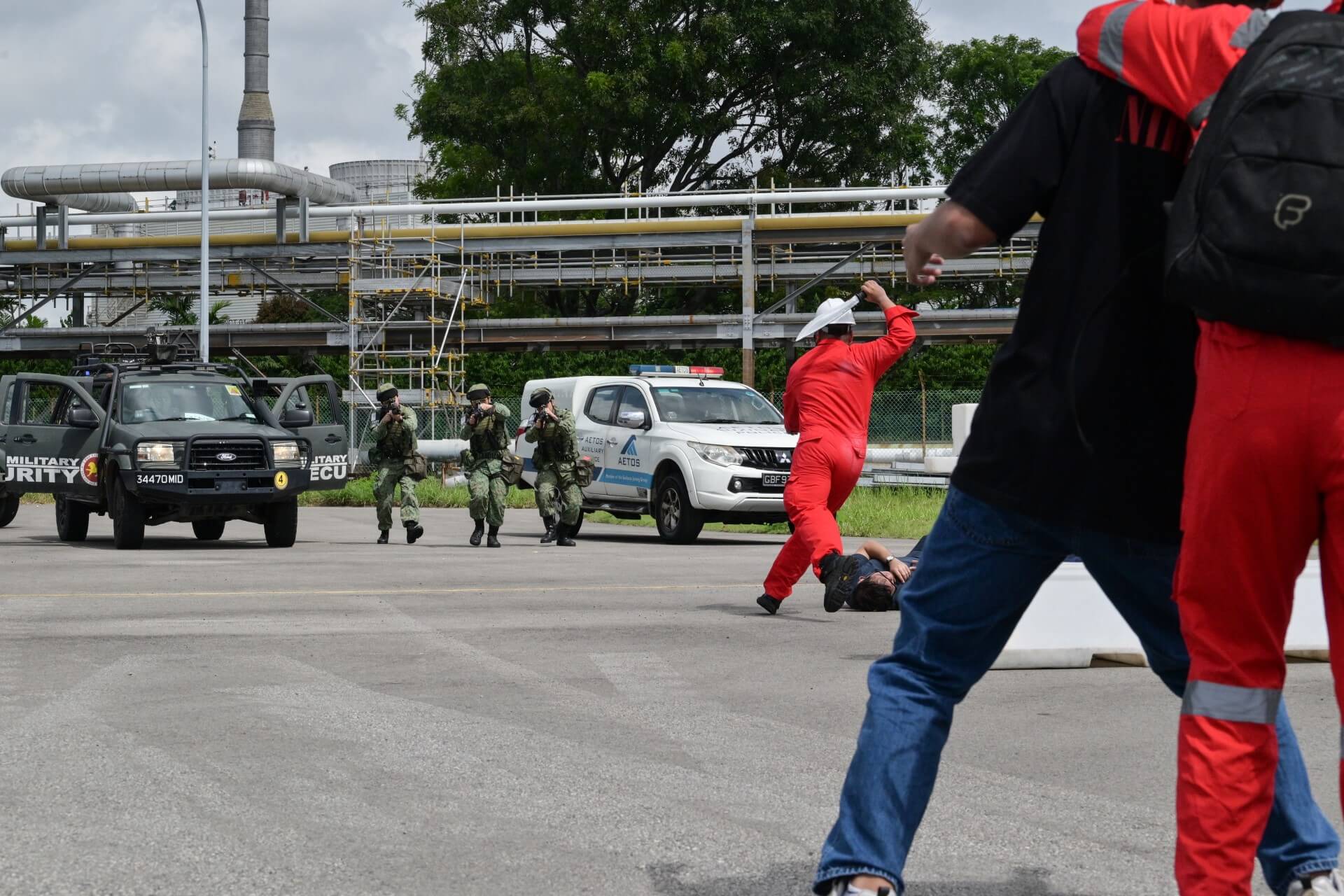SAF AND KEY AGENCIES TACKLE THREATS ON JURONG ISLAND
//Story by KOH ENG BENG //Photos by AMOS CHEW
Exercise Northstar XI saw national security agencies come together to neutralise "attacks" on Jurong Island on 22 Mar.
This year's exercise involved more than 300 officers and personnel from various national agencies and stakeholders such as the Singapore Armed Forces (SAF), Home Team, ExxonMobil, Maritime & Port Authority of Singapore, and the Ministry of Health.
Boom!
The scenario: A small group of self-radicalised individuals planted Improvised Explosives Devices (IEDs) on large oil tanks and chemical pipelines on Jurong Island.
While attempting to flee via a small craft, they encounter Auxiliary Police Officers (APOs) and attacked the officers.
The IEDs were then remotely set off when one of the perpetrators was neutralised. The explosions cause massive fires and a toxic chlorine gas leak from the partially ruptured pipelines.
First blood
The APOs then call in troopers from 9th Battalion, Singapore Infantry Regiment (9 SIR) to assist in dealing with the perpetrators. They are the first to respond. The SAF unit is stationed on Jurong Island for 24/7 security operations.
A face-off ensues. The Singapore Police Force (SPF) arrives on scene to take over command and control of the situation, and neutralises the rest of the group. Seeing this, the perpetrators' small craft attempted to escape and was intercepted by the Police Coast Guard.
Establishing control
At the same time, tactical headquarters from the SAF's Island Defence Task Force (IDTF), Singapore Civil Defence Force (SCDF), and SPF are being set up for collective sense-making, planning, coordination of responses, and tracking of their own forces' location.
Soldiers from the SAF's 15th Command, Control, Communications, Computers and Intelligence Battalion (15 C4I Bn) set up a Forward Command Post (FCP).
The FCP is equipped with the Next Generation Command and Control Information System (CCIS) which provides commanders with a comprehensive situational picture. It allows commanders to better coordinate responses across the various agencies, as well as deploy troops and assets effectively.
The soldiers also set up Pan-Tilt-Zoom (PTZ) cameras at various locations for surveillance.
The PTZ camera has an advanced optical zoom function which allows surveillance on targets from a safe distance away. It is also equipped with intelligent tracking capabilities, allowing it to monitor persons and vehicles of interest.
Potential second attack
It is not over yet. Intelligence reports warn of a secondary attack at Jurong Island Checkpoint and soldiers work to secure the area by quickly closing Jurong Island Highway.
The SCDF is called in to rescue and evacuate casualties. With the closure of the highway, evacuation of casualties over land to mainland Singapore is not an option.
The evacuees are ferried to mainland Singapore via vessels from SCDF, the Maritime and Port Authority of Singapore, as well as the Republic of Singapore Navy's (RSN's) Fast Craft Utility.
Multi-agency response critical for Singapore's security
Prime Minister Lee Hsien Loong visited the exercise on 22 Mar. Mr Lee said that Singapore takes terrorist threats very seriously as the country is on the radar of terrorist groups in the region and beyond.
Homegrown self-radicalised individuals can also cause harm if they are not caught in time, he added.
Speaking to the media, he said: "Today's exercise tests out a lot of equipment we have...the drills, the coordination…and making sure everything works, and if we press the button, we're there," said Mr Lee.
Exercise Northstar serves to test and validate the Whole-of-Government response framework that Singapore has put in place to safeguard national security and its ability to recover quickly from a crisis, should an incident occur.










